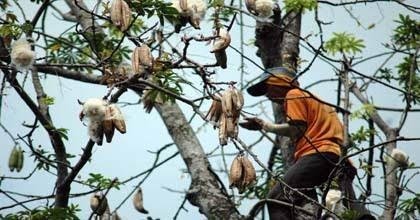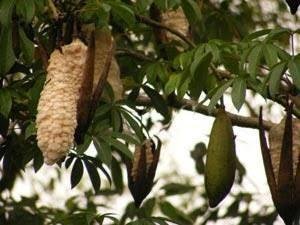

Kapok or kapok (Ceiba pentandra) is a tropical tree belonging to the order of Malvales and the Malvaceae family (formerly grouped into separate families Bombacaceae), originating from the northern part of South America, Central America and the Caribbean, and (for the variant C. pentandra var. guineensis) comes from the west of Africa. The word "kapok" or "kapok" is also used to refer to the fibers produced from the seeds. This tree is also known as Java cotton or kapok Jawa, or cotton-silk trees. Also referred to as Ceiba, the name of the genus, which is a sacred symbol in Maya mythology.

This tree grows to as high as 60-70 m and can have a tree trunk large enough to reach 3 m diameter.
This tree is widely grown in Asia, especially in the islands of Java, Malaysia, Philippines, and South America. In Bogor there is a road along the edge shaded by a kapok tree. By the time the fruit blooms in the street it resembles a snowfall due to the white cotton fibers flying through the air.
kapok is a tree with a height of 70 ,. roots spread hozontal, surface of the soil. stems or with tampa branches, sometimes hunting. kapok grows well at <500 m height. night temperatures below 17 degrees Celsius. kapok likes abundant rainfall. rainfall should be about 1500 mm / year. the tree is easily rusaj by a strong wind. kapok fruit is a source of fiber, used for basic materials mat, pillow, wall wear, protective clothing, and retaining heat and sound. dry skin dugunakaan as fuel, oil-containing seeds used in the industry as lubricants and oil lamps, therefore can be used as energy raw materials. young leaves are fed as vegetables in the Philippines, flowers and young fruit are eaten in Thailand, and very young pods are eaten.
Hi! I am a robot. I just upvoted you! I found similar content that readers might be interested in:
https://steemit.com/homesteading/@myart/understand-about-kapok-and-its-benefits
Downvoting a post can decrease pending rewards and make it less visible. Common reasons:
Submit